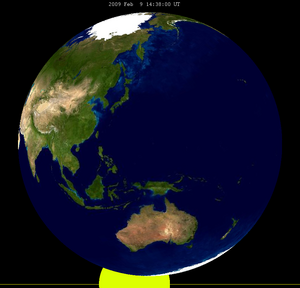Astronomy:Partial eclipses on the Moon
Partial solar eclipses on the Moon are caused when the Earth passes nearly in front of the Sun, blocking a part of its light. Viewers on Earth will see a penumbral lunar eclipse.[1]
During its eclipses, the Earth will be in new phase, completely dark, except for moonshine and sunlight refracted through the earth's atmosphere, visible as a ring of light.[2]
Penumbral shadow
Unlike the Earth's which shows slightly darker shadows at 50% obscuration and mostly dark at over 75% obscuration, the Moon's penumbral shadow on the surface shows light yellow at the start and the end of the eclipses as available light from the Earth's atmosphere shines as light yellow, at about 10-15% obscuration, it shows yellow. In the middle between the start and the totality or the totality and the end of the eclipse shows the surface as orange at 50% obscuration. Before and after totality for a short time shows the surface as red.
Partial eclipses
On the Moon, when there is a partial eclipse, one example is when half of the Sun is blocked (north or south), a part of the moon has a partial eclipse (north or south). In some partial eclipses when the center of the Earth's shadow misses the moon, one example is one hemisphere has a partial eclipse and the other does not.
In some eclipses, its penumbral shadow covers the whole surface whereas the center of the Earth's shadow missed a portion of the moon while every part of the Nearside sees a partial eclipses. On Earth, they are seen as a Total penumbral eclipse.[1]
Length
Some of its partial eclipses lasts under 30 minutes and are short especially some eclipses lasting under an hour. These occur near and within the polar areas and the northern or southern areas of the Moon. Eclipses lasting between 1 and 2 hours has a part of the hemisphere or its surrounding seen as partially. Eclipses lasting about two to three hours sees most of a part of the moon as partial. Eclipses seen for more than three hours covers much of the Moon. Eclipses seen for less or more than 4 hours covers the whole moon, several of them are rare. These occur when the Moon is slightly distant from the Earth (ex. on Earth, the apparent diameter of the moon being small than the sun's).
See also
- Solar eclipses on the Moon
- Partial eclipse - Partial eclipses that are seen on Earth that its light are partly blocked by the Moon for an hour or more
- Total penumbral eclipse - Some of its partial eclipses that are seen on Earth that its light are partly blocked by the Moon
- Partial/total eclipses on the Moon - one part of the Moon is visible as partial and the other as total
References
- ↑ 1.0 1.1 Lunar eclipses
- ↑ The Earth will be in new phase, completely dark, except for moonshine and sunlight refracted through the earth's atmosphere, visible as a ring of light.


